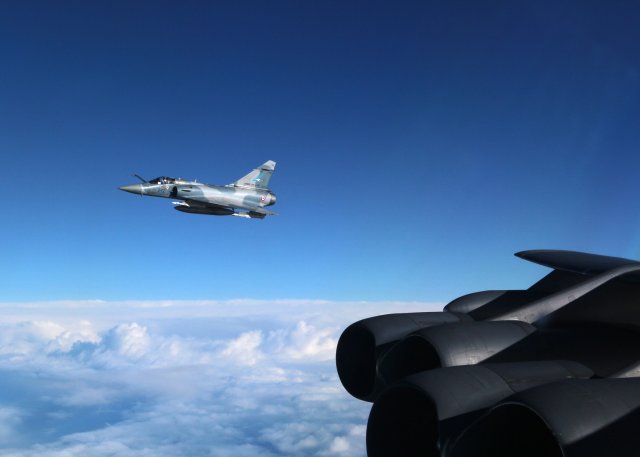Breaking news
USAF B-52 Stratofortress bombers join French-led exercise Serpentex.
| a | |||
|
|
|||
|
World Defense & Security News - France & United States
|
|||
|
|
|||
|
USAF B-52 Stratofortress bombers join French-led exercise Serpentex
|
|||
|
U.S. Air Force B-52 Stratofortresses joined French aircraft and ground troops from a dozen nations to kick off a close air support exercise in the Mediterranean March 7. Serpentex, an annual French-led exercise, involves joint terminal attack controllers from 12 partner countries.
|
|||
|
|
|||
 A French Mirage 2000 holds station off the wing of a U.S. Air Force B-52 Stratofortress in the skies over northern France March 1, 2016 A French Mirage 2000 holds station off the wing of a U.S. Air Force B-52 Stratofortress in the skies over northern France March 1, 2016(Credit: US Air Force) |
|||
|
|
|||
|
Operating on the French island of Corsica, the JTACs work together to practice properly identifying targets and using that data to call in air strikes from nearby French and American aircraft.
"Serpentex is a great opportunity to have all the JTACs from coalition nations in one place, training together to increase interoperability and work on communication skills," said Maj. Sarah Fortin, the 20th Expeditionary Bomb Squadron assistant director of operations. "It gives them a chance to train and get smart on what they have to do and what their capabilities are, so later on down the road when it counts, they can perform effectively and efficiently." Serpentex differs from other joint-military exercises in the region as it concentrates solely on close air support. This critical capability puts the power of precise, concentrated air strikes in the hands of troops on the ground, who can call these strikes in to defend themselves against enemy attacks or to eliminate vital targets with lethal accuracy. This is the first year B-52s have been invited to participate in the exercise, as the role of close air support has traditionally been filled by various fighter platforms. The Stratofortress is well-suited for this application, however, as it can loiter for extended periods and carries a wider range of munitions than any other aircraft in the U.S. inventory. During the exercise, the B-52s joined with French fighters to support JTACs from several NATO nations, as well as those from Jordan and Saudi Arabia, who are also participating this year. Training with a wide range of mission partners ensures a more comprehensive learning experience, Fortin explained. "Working alongside our coalition partners out there will be a great experience for everybody," Fortin said. "Most of them haven't worked with bombers for these types of missions before. We have a longer duration and a lot wider turn radius than some of the fighters, so they're going to have to find a new pacing for calling us in for close air support. But I promise that bomber CAS is worth the wait." The B-52s involved in Serpentex also participated in the Norwegian-led Cold Response 16, a large-scale NATO military training exercise in the Trøndelag region of Norway involving 16,000 troops and comprising air, ground and maritime operations. The bombers will be participating in both exercises simultaneously for a short time as Cold Response winds down. Temporarily stationing the aircraft in Europe allowed for more sorties, shorter flight times, less fuel burned and more training hours. "The ability to train bomber aircrews in different geographic combatant commands is essential to maintaining a strong, credible bomber force that enhances the security and stability of our allies and partners," said Lt. Col. Dennis Cummings, the 20th Expeditionary Bomb Squadron commander. "Our ability to smoothly and effectively conduct these multinational missions is heavily indebted to the hospitality of Spain and fantastic support we are receiving from U.S. Air Forces (in) Europe." |
|||



















